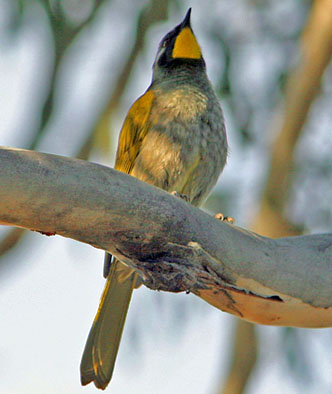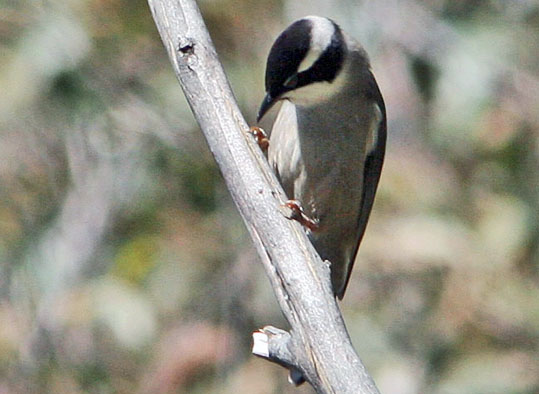
a web page by Don Roberson |
HONEYEATERS Meliphagidae |
||
|
||
At least "one species occurs in every terrestrial habitat in Australia, from tropical rain forest to arid shrubland, from mangroves to suburbia" (Simpson & Day 1996). The Western Spinebill (left), for example, is an endemic of coastal southwestern Australian, where it feeds on nectar from an abundance of wild-flowers, from kangaroo-paws to grevilleas (Morcombe 2000). Spinebills are unique, fine-billed birds of undergrowth and thickets, with one species in the west and another in the east. This male is defending his territory in Two Peoples Bay NR from an intruder — his own image in our rental car window. The radiation and multiplicity of forms of honeyeaters are equally impressive in New Guinea, where numerous species reside in specific elevational zones from lowlands to alpine scrub. Smoky Melipotes (below, sometimes called Smoky Honeyeater) is one of 4 species of large Melipotes honeyeaters with colorful eye-wattles that are distributed at higher elevations in cloud forests of New Guinea. All are fruit-eaters in the forest canopy. |
||
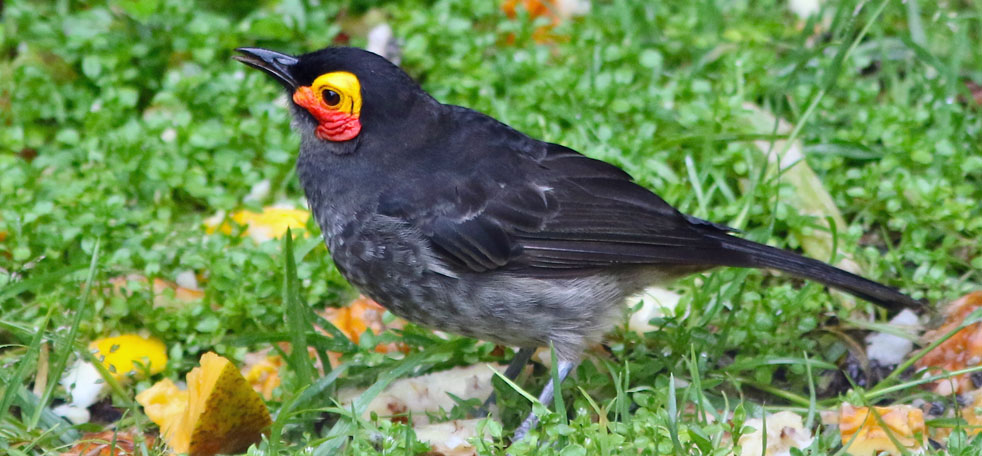 |
||
The most successful of the honeyeaters are three genera that evolved in New Guinea but are now widely dispersed into Wallacea and across the South Pacific: the genera Lichmera, Myzomela, and Philemon. An example of Lichmera is Dark-brown Honeyeater (left) of New Caledonia. There are ~11 species of Lichmera, mostly dull brown or olive jobs with decurved bills for nectar feeding. Five of them have spread to the Lesser Sundas and thus are considered to be part of the Asian avifauna (if one uses Lydekker's Line as the dividing line). Only one of them — Indonesian Honeyeater L. limbata — crosses Wallace's Line and occurs on Bali. [Wallace's Line runs through the deep-water Lombok strait, between Bali and Lombok, and is a fair bit west of Lydekker's Line.] This is the extent of meliphagid dispersion to the east — no honeyeaters have invaded the Asian mainland. Presumably they are out-competed by other families that arose there.
|
||
All Myzomela honeyeaters are small birds, and most are patterned in various combinations of red, black, brown, red-and-brown, or red-and-black. Some are all-red or all-black or all-brown. All have with a fine, decurved bill adapted for nectaring on flowers. Three Myzomelas reach Australia, where they are usually called "honeyeaters" in English. The male Scarlet Myzomela (above right) is a striking red-and-white bird. The species moves nomadically in search of flowering plants in eastern Australia. |
||
White-streaked Friarbird (left) is a smaller friarbird, endemic to the Moluccan islands, and the only member of genus Melitograis. The various friarbirds are fruit-eaters and also glean for arthropods; this species also nectars in flowering trees. |
||
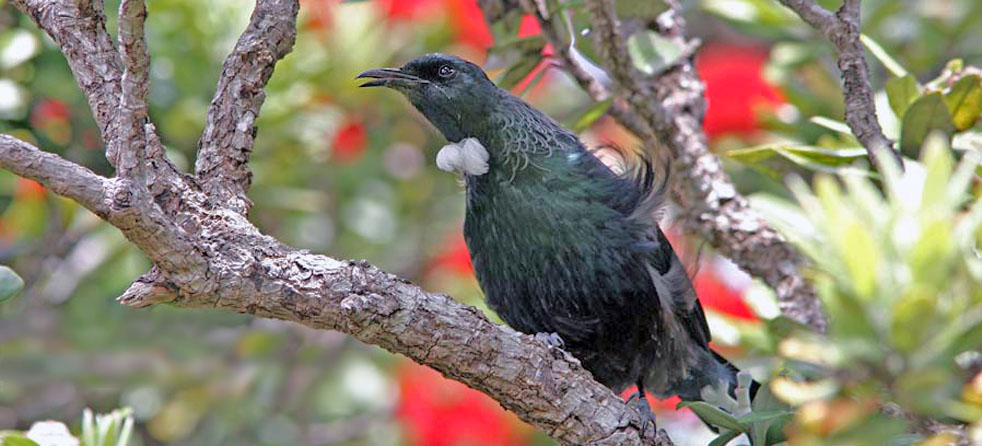 |
||
In Sulawesi, two unique species of montane forests are called Myzas (genus Myza). These are dark-bodied, with longish bills and tails, and this Sulawesi endemic has a prominent white patch on the face: White-eared Myza (right). Far to the west, there are three species of Foulehaio wattled-honeyeaters spread among the islands of Fiji and Samoa, and other nearby South Pacific islands. In Fiji, are two species of Gymnomyza giant-honeyeaters These are substantially larger forest birds, and named for their vocalizations: Chattering Giant-Honeyeater G. viridis and Dueting Giant-Honeyeater G. brunneirostris. The Mao is an endangered Gymnomyza in Samoa. The final member of this impressive genus is Crow Honeyeater G. aubryana of New Caledonia, a blackish, essentially crow-sized honeyeater, with a complex facial pattern of red or yellow bare skin and wattles. It is considered Critically Endangered, and was certain our most impressive endemic there after seeing the Kagu. |
||
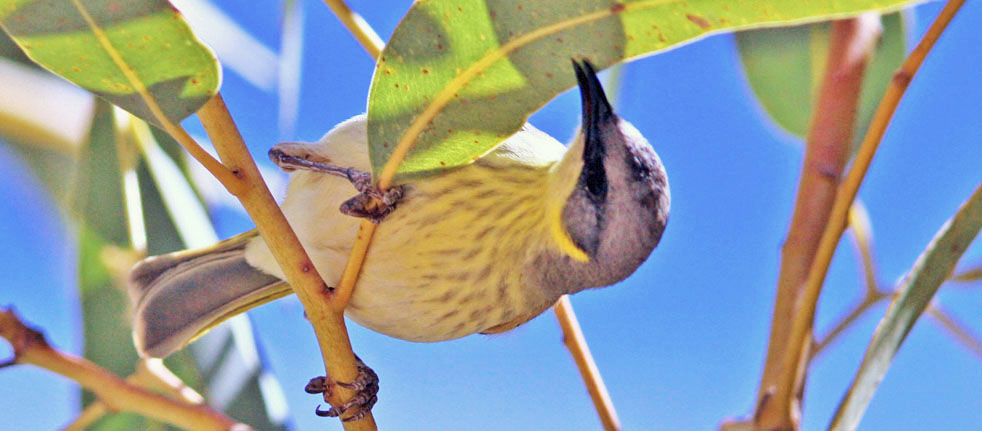 |
||
One of the most striking — it certainly caught my attention during my first visit to Australia about 40 years ago, when I saw it in Royal NP, south of Sydney — is New Holland Honeyeater (left & below). It is a common bird of coastal heathland along the east and southern coasts of Australia but every time I see one I want to take another photograph. So here's another shot of a different individual (below; both photos taken at different sites in Western Australia). |
||
Macleay's Honeyeater is one of 3 species in genus Xanthotis; it is endemic to northeast Australia but the other two Xanthotis are in New Guinea. This is one of many genera in which adult male and females generally appear quite similar. In contrast, other honeyeaters in various genera are strongly dimorphic in plumage, with males that do not remotely resemble females. A fine example is Pied Honeyeater (male below left, female below right). It is in its own monotypic genus (Certhionyx) and is a bird of the hot, arid interior, preferring Eremophila or Grevillea scrub. It is nomadic and therefore quite erratic in occurrence. |
||
|
||
Many species of honeyeater are adapted to eucalyptus blossoms, but a wide variety of flowering plants are visited. The five species of wattlebirds (genus Anthochaera) in southern Australia are examples of generalist in foraging of flowering plants (the exception in the genus is Regent Honeyeater A. phrygia, a critically endangered species that prefers box-ironbark Eucalyptus woods). The four wattlebirds themselves are large, lanky, long-tailed species that can be common in urban and suburban gardens and parks. Only two of the four wattlebirds have wattles. Yellow Wattlebird (below left, in a nice shot by Murray Lord) is an endemic of Tasmania and King Island, where it occurs in small flocks. It is a noisy, acrobatic bird attracted to flowering trees. It is also the largest honeyeater in Australia, edging out Blue-faced Honeyeater (below right) of northern Australia and the Trans-Fly region of southern New Guinea for that claim. Blue-faced is a butcherbird-sized honeyeater of open woodlands that uses old nest of Australo-Papuan babblers [Pomatostomidae] as a base for its own nests, sometimes evicting the original tenants by force. |
||
|
||
 |
||
Spiny-cheeked Honeyeater (left) is a bird of the arid interior, occurring in pairs or small parties. frequently takes nectar and fruit of mistletoes (Loranthaceae) growing on diverse range of plants; sometimes forages on ground or aerially. Probes flowers for nectar, and gleans (plucks) fruits; arthropods obtained by gleaning and sallying Honeyeaters have a close mutual association with the Australasian flora. They are important pollinators of many Australasian trees and bushes (e.g., Eucalyptus, Banksia, Callistemon, Correa, Epacris) and they disperse the seeds of various acacias and mistletoe, among others (Simpson & Day 1996, Higgins et al. 2008). Like the hummingbirds of the Andes, which have evolved in concert with the flowers on which they both feed and pollinate, honeyeaters and these Australasia flora are tied together by mutual bonds of dependence. Neither can survive without the other. Biochemical evidence supports the notion that the many different honeyeaters are a monophyletic group (Driskell & Christidis 2004), although various specific birds that have been in the past assigned to honeyeaters are not. Bonin Island Honeyeater Apalpteron familiare of Bonin Island, Japan, is not a honeyeater but is a white-eye (e.g., Sibley 1996). The longbills and "pygmy honeyeaters" of New Guinea (genera Oedistoma and Toxorhamphus) are not honeyeaters but are berrypeckers [family Melanocharitidae] but the two species of straightbills in New Guinea (genus Timeliopsis) are, indeed, honeyeaters (Driskell & Christidis 2004). Most impressive: MacGregor's "Bird-of-Paradise" Macgregoria pulchra of alpine meadows in New Guinea is not a bird-of-paradise, but is a giant honeyeater most closely related to Melipotes honeyeaters (Cracraft & Feinstein 2000). It now becomes MacGregor's Honeyeater, the largest honeyeater on earth. |
||
Sibley & Ahlquist (1990) were the first to include the Australian chats among the Meliphagidae, largely on biochemical evidence but also because they have brush-tipped tongues. Further DNA analysis (e.g., Christidis & Boles (994, Driskell & Christidis 2004) confirms that this group is "nested deeply within the family Meliphagidae." This was a big surprise since they "seem" so different that other honeyeaters, They were traditionally considered a separate family and they sort-of filled a "pipit" niche: they walk on the ground rather than hop. [Later, a pipit colonized Australia from Asia and evolved into its own species: Australasian Pipit Anthus novaeseelandiae.] Four species of Australian chats are in the genus Epthianura, including Yellow Chat (below left; nice shot of a male by Hans & Judy Beste). It is one of the hardest to find, being patchily distributed in saltbush lagoons of northern Australia (Bakers et al. 1984). Because its locales are often hard to reach, and even when reached it is inconspicuous in behavior, it remains a little known species. Other Epthianura species are more widespread: Crimson (photo above right), Orange E. aurifrons, and White-fronted E. albifrons chats. The remaining bird is in its own genus (Ashbyia) and used to be known as the "Gibberbird" — it is now known as Gibber Chat (below right). It is a terrestrial bird of stony desert and short grass plains in south-east central Australia: the Gibber plains. It stands upright on rocks, like a wheatear, but wags its tail like a pipit. The rocks on which the photographed chat is standing exemplify the Gibber plaints. |
||
|
||
Other New Guinea honeyeaters run to the more dramatic, all the way to the huge and spectacular MacGregor's Honeyeater Macgregoria pulchra. Some sport to bare wattles around the face (3 montane New Guinea endemics in Melipotes), while others wear plumed "beards" (e.g, a few of the Melidectes species), and some are just straight-impressive with long decurved bills and contrasting facial patterns, such as Belford's Melidectes (below) of montane cloud forests. |
||
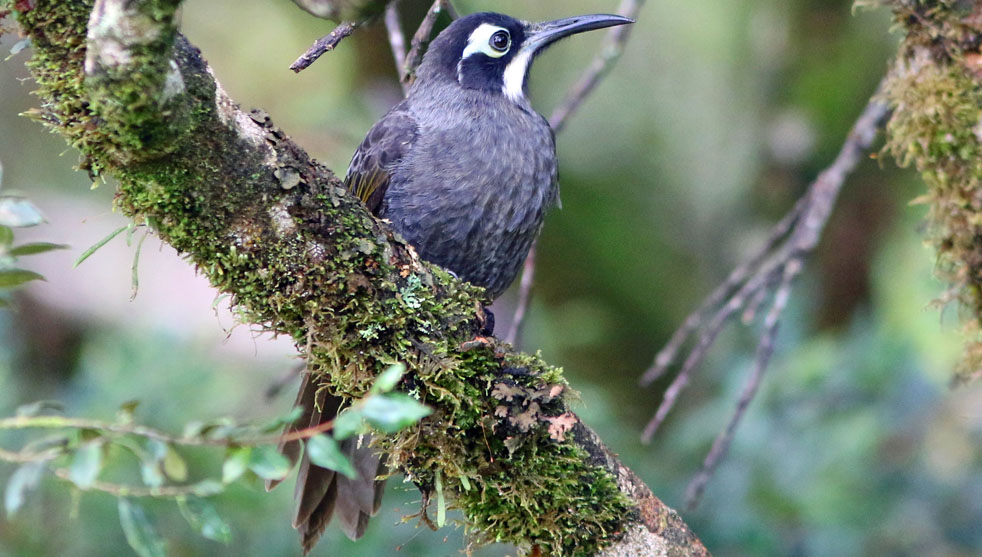 |
||
The best I can do is end with a couple more photos to further emphasize the biodiversity of the family. These are both endemics to Tasmania: Yellow-throated Honeyeater (below left) and Strong-billed Honeyeater (below right). |
||
|
||
Photos: The window-jousting Western Spinebill Acanthorhynchus superciliosus was at Two Peoples Bay NR, Western Australia, on 11 Aug 2008. The Smoky Melipotes Melipotes fumigatus was at Kumul Lodge, Papua New Guinea, on 10 Sep 2016. The Dark-brown Honeyeater Lichmera incana was at Parc du Riviere Bleue, New Caledonia, on 7 Jan 1998. The flying Micronesian Myzomela Myzomela rubratra was on Moen I., Truk [Chuuk], Micronesia, on 30 Aug 1978. The Scarlet Myzomela Myzomela sanguinolenta was at Pullenvale, Queensland, on 3 Sep 2016. The Helmeted Friarbird Philemon bucerodies was at a feeder at Cassowary House, Kuranda, Queensland, on 3 Jan 1998. The White-streaked Friarbird Melitograis gilolensis was at the crest of the Buli-Subaim Road, on Halmahera, Indonesia, on 11 Oct 2011. The Tui Prosthemadera novaeseelandiae was on Tiritiri Matangi I., New Zealand, on 13 Nov 2009. The White-eared Myza Myza sarasinorum was in Lore Lindu NP, Sulawesi, Indonesia, on 28 Sep 2011. The Gray-headed Honeyeater Ptilotula keartlandi was in the Ormiston Gorge, Northern Territory, Australia, on 17 Aug 2008. The two photos of New Holland Honeyeater Phylidonyris novaehollandiae were at Narrogin, on 5 Aug 2008, and at Waychinicup NP, on 20 Aug 2008, both in Western Australia. The Macleay Honeyeater Xanthotis macleayana at a feeder at Cassowary House, Kuranda, Queensland, on 3 Jan 1998. The male and female Pied Honeyeater Certhionyx variegatus were at Port Augusta on 22 Nov 2009 and at Goyders Lagoon on 2009, respectively, both in South Australia. Murray Lord photographed the Yellow Wattlebird Anthochaera paradoxa at Hobart, Tasmania, in Dec 2005. The Blue-faced Honeyeater Entomyzon cyanotis was near Mt. Carbine, Queensland, on 2 Nov 1983. The Noisy Miner Manorina melanocephala was at Lake Galletly, Queensland, on 3 Sep 2016. David Fisher photographed the Crimson Chat Ephthianura tricolor in the Australian interior in Oct 2006 [he says the male was courting a female, and responded to squeaking]. Hans & Judy Beste photographed the male Yellow Chat Epthianura crocea near the South Alligator River, Northern Territory, Australia, in 1980. The Gibber Chat Ashbyia lovensis was along the Birdsville Track, South Australia, on 21 Nov 2009. The Elegant Honeyeater Microptilotis cinereifrons was at Brown River Rd., near Port Moresby, Papua New Guinea, on 14 Sep 2016. The Belford's Melidectes Melidectes belfordi was at Kumul Lodge, Papua New Guinea, on 10 Sep 2016. The Mangrove Honeyeater Gavicalis fasciogularis was at Luggage Pt., Brisbane, Queensland, on 3 Sep 2016. The Yellow-throated Honeyeater Nesoptilotis flavicollis was at the Peter Murrell Reserve, Tasmania, on 21 Aug 2008. The Strong-billed Honeyeater Melithreptus validirostris was at Ferntree, Hobart, Tasmania, on 21 Aug 2008.
Bibliographic note: There has never been a complete family book on the Honeyeaters, although Longmore (1991) covered all the Australian species which were then thought included in the family. It was comparatively superficial when considered among other family tomes. The Handbook of the Birds of the World has an excellent introduction to the family (Higgins et al. 2008), although many generic assignments have changed since then. Literature cited:
|
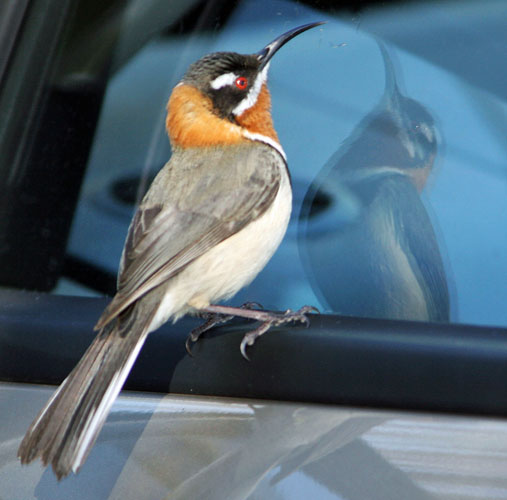 The
Honeyeaters are a very large family restricted to
Australasia and some South Pacific islands. The Meliphagidae are a dominant group in Australia (over 70 species) and in New
Guinea (over 60 species). In some habitats more than a dozen species
co-occur seasonally.
The
Honeyeaters are a very large family restricted to
Australasia and some South Pacific islands. The Meliphagidae are a dominant group in Australia (over 70 species) and in New
Guinea (over 60 species). In some habitats more than a dozen species
co-occur seasonally. 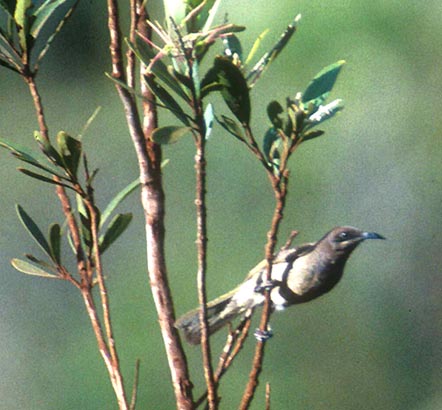 Honeyeaters are among the most
successful of the families that arose during the great Australasian
radiation, during which time many types of birds evolved in isolation for
eons. The
major groups in that radiation are divided between the menurids
(including the lyrebirds, scrub-birds, fairy-wrens and relatives) and
the corvoids (crows, birds-of-paradise, drongos, and numerous
relations). The honeyeaters are in the menurid group (Sibley &
Ahlquist 1990).
Honeyeaters are among the most
successful of the families that arose during the great Australasian
radiation, during which time many types of birds evolved in isolation for
eons. The
major groups in that radiation are divided between the menurids
(including the lyrebirds, scrub-birds, fairy-wrens and relatives) and
the corvoids (crows, birds-of-paradise, drongos, and numerous
relations). The honeyeaters are in the menurid group (Sibley &
Ahlquist 1990). 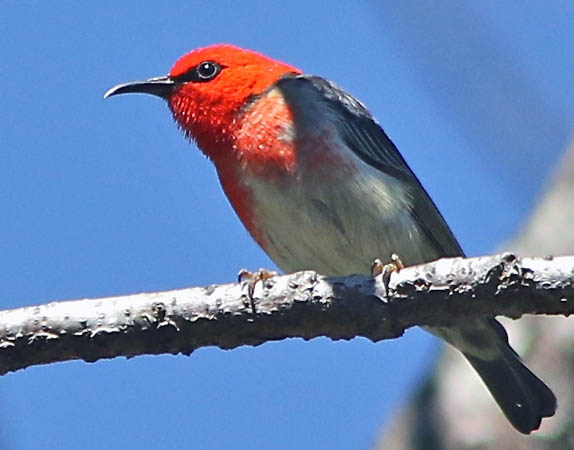 In contrast, Myzomela honeyeaters have met no competitors and have colonized most of the
islands in the south Pacific: the ~33 species are now scattered east to Fiji, west of Timor, and north to
Micronesia. The Micronesian Myzomela (below) is the northernmost species in the western Pacific. It is bright red. [This is from a digitized slide, taken on Truk (Chuuk) back in 1978, when it was called "Cardinal Honeyeater." It has since been split, with Cardinal Myzomela reserved for the species in the Solomon & Loyalty Is., and Vanuatu.]
In contrast, Myzomela honeyeaters have met no competitors and have colonized most of the
islands in the south Pacific: the ~33 species are now scattered east to Fiji, west of Timor, and north to
Micronesia. The Micronesian Myzomela (below) is the northernmost species in the western Pacific. It is bright red. [This is from a digitized slide, taken on Truk (Chuuk) back in 1978, when it was called "Cardinal Honeyeater." It has since been split, with Cardinal Myzomela reserved for the species in the Solomon & Loyalty Is., and Vanuatu.]
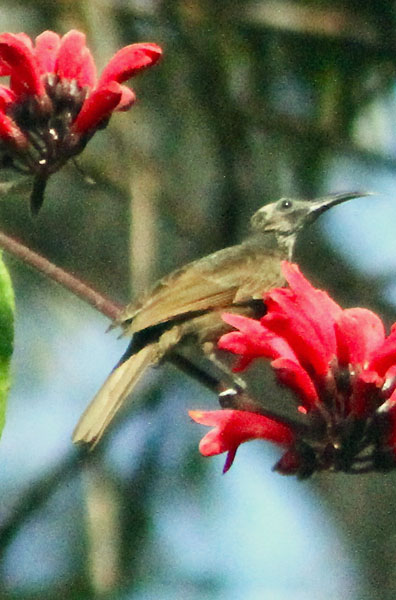 The final genus with more than ten species is the Philemon friarbirds (~16 species). Like Lichmera and Myzomela, only a small handful of Philemon friarbirds are in Australia, with the majority distributed on tropical islands from Wallacea and the Lesser Sundas to the South Pacific, and widely on New Guinea (even 3 of the 4 Australian species are shared with New Guinea). Friarbirds are very large honeyeaters with long, heavy bills and often much bare skin of their face. This (below) is a close-up of the head of Helmeted Friarbird that was
visiting a feeder inside the forest on the Atherton tablelands of
northeast Australia. One can see the extent of the bare face in this species, its casqued-like bill, and its white-ruffed neck and breast feathers that recall the attire of Catholic friars from the Middle Ages.
The final genus with more than ten species is the Philemon friarbirds (~16 species). Like Lichmera and Myzomela, only a small handful of Philemon friarbirds are in Australia, with the majority distributed on tropical islands from Wallacea and the Lesser Sundas to the South Pacific, and widely on New Guinea (even 3 of the 4 Australian species are shared with New Guinea). Friarbirds are very large honeyeaters with long, heavy bills and often much bare skin of their face. This (below) is a close-up of the head of Helmeted Friarbird that was
visiting a feeder inside the forest on the Atherton tablelands of
northeast Australia. One can see the extent of the bare face in this species, its casqued-like bill, and its white-ruffed neck and breast feathers that recall the attire of Catholic friars from the Middle Ages.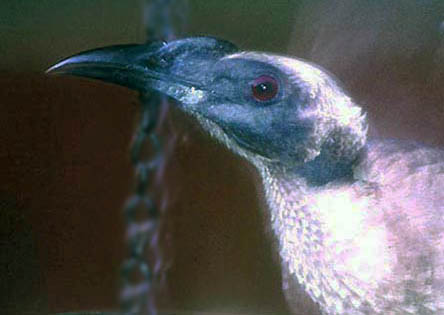
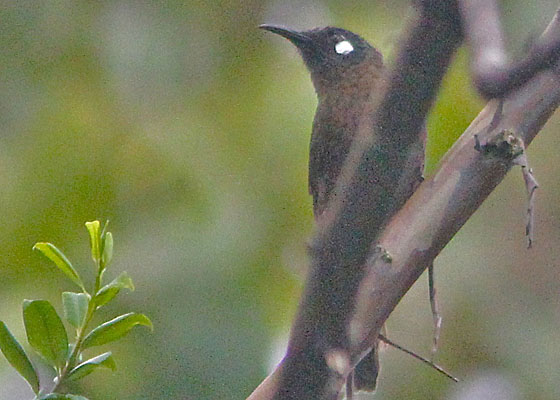 Honeyeaters
have colonized and thrived in New Guinea, in Wallacea and many South Pacific islands,
and in New Zealand. One of the most unique is the Tui (above) of New Zealand, with its feathered throat ornament recalling an
old English cleric's collar (and thus the old name "Parsonbird"). The
Tui can be very territorial around its nest or a favored food source,
and vigorously chase other Tui and other birds from their territory.
When breeding, they may commute up to 10 km in a day to visit a prime
nectar source. They also soar above the canopy and then make a noisy,
near-vertical dive back into the forest. Their song is rich, fluid, and
complex "with croaks, coughs, clicks, grunts, wheezes and chuckles"
(Heath & Robertson 1996). Recent molecular studies have confirmed
that the Tui is a honeyeater (Driskell et al. 2007).
Honeyeaters
have colonized and thrived in New Guinea, in Wallacea and many South Pacific islands,
and in New Zealand. One of the most unique is the Tui (above) of New Zealand, with its feathered throat ornament recalling an
old English cleric's collar (and thus the old name "Parsonbird"). The
Tui can be very territorial around its nest or a favored food source,
and vigorously chase other Tui and other birds from their territory.
When breeding, they may commute up to 10 km in a day to visit a prime
nectar source. They also soar above the canopy and then make a noisy,
near-vertical dive back into the forest. Their song is rich, fluid, and
complex "with croaks, coughs, clicks, grunts, wheezes and chuckles"
(Heath & Robertson 1996). Recent molecular studies have confirmed
that the Tui is a honeyeater (Driskell et al. 2007). 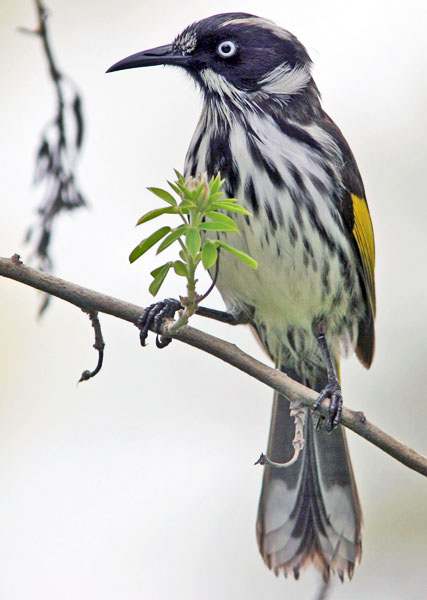 As Australia has many more birders than New Guinea, Wallacea, or the South Pacific, the Australian honeyeaters are the best known. Many are small or mid-sized honeyeaters of Eucalyptus or Acacia woodlands, such as the widespread Australian interior species, Gray-headed Honeyeater (above).
As Australia has many more birders than New Guinea, Wallacea, or the South Pacific, the Australian honeyeaters are the best known. Many are small or mid-sized honeyeaters of Eucalyptus or Acacia woodlands, such as the widespread Australian interior species, Gray-headed Honeyeater (above).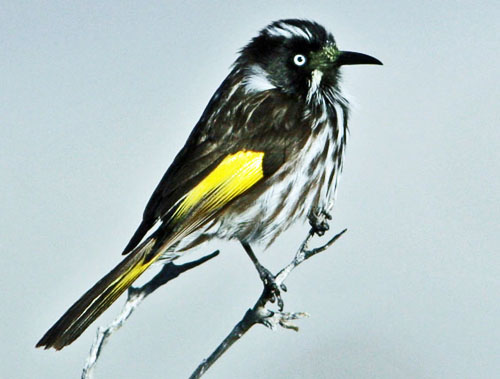
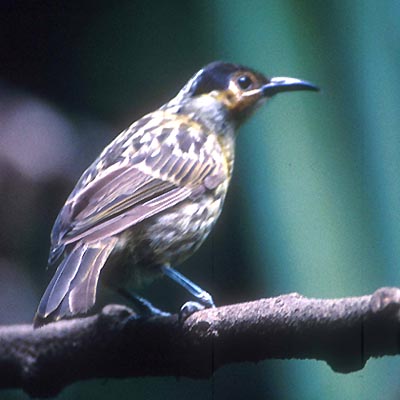 In Australia, honeyeaters are major pollinators of many endemic plants. Macleay's Honeyeater
(right), for example, pollinates forest plants on the York Peninsula.
The principal anatomical feature of the family is a brush-tipped tongue
that functions like a paint brush, collecting fluids by capillary
action. There are many variations in the details of tongue structure
among the species, but most feed by inserting the tongue in the nectar
of a flower, extending and retracting it about 10 times per second,
squeezing out the liquid against projections in the roof of the mouth,
and allowing the liquid to flow along the grooves into the throat. The
alimentary tract is also adapted for nectar in an arrangement that lets
the liquid pass directly to the intestines but separating things that
require more digestion, like insects caught during the feeding, to be
retained in a separate chamber of the stomach (Higgins et al. 2008).
In Australia, honeyeaters are major pollinators of many endemic plants. Macleay's Honeyeater
(right), for example, pollinates forest plants on the York Peninsula.
The principal anatomical feature of the family is a brush-tipped tongue
that functions like a paint brush, collecting fluids by capillary
action. There are many variations in the details of tongue structure
among the species, but most feed by inserting the tongue in the nectar
of a flower, extending and retracting it about 10 times per second,
squeezing out the liquid against projections in the roof of the mouth,
and allowing the liquid to flow along the grooves into the throat. The
alimentary tract is also adapted for nectar in an arrangement that lets
the liquid pass directly to the intestines but separating things that
require more digestion, like insects caught during the feeding, to be
retained in a separate chamber of the stomach (Higgins et al. 2008). 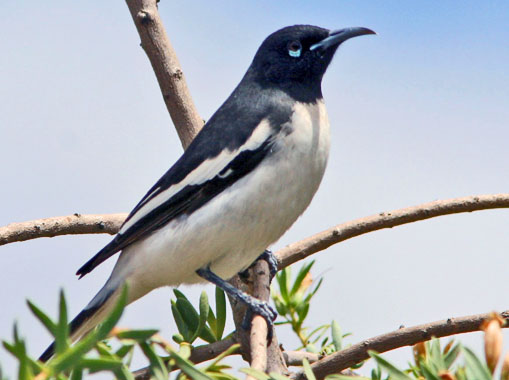
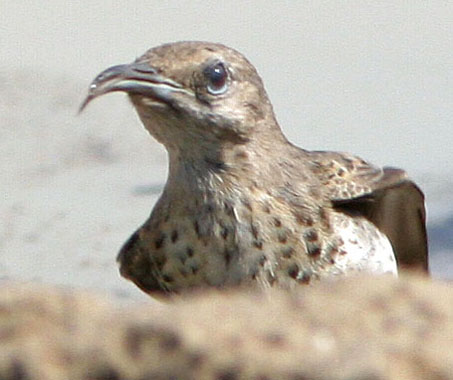
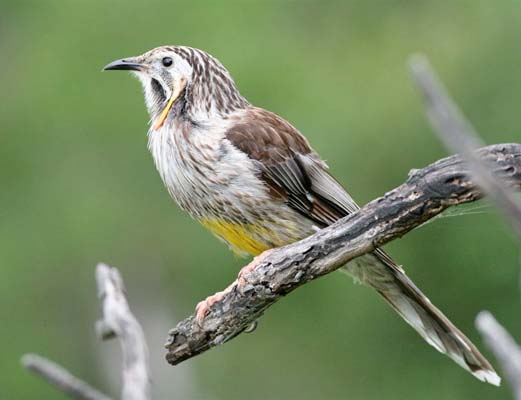
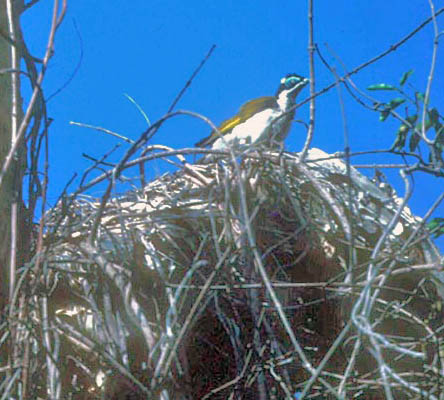
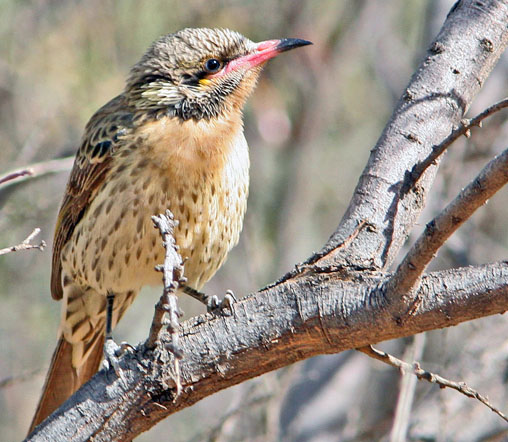 Many honeyeaters weave fragile,
beautifully made cups of grasses and cobwebs, and suspend them from
bushes and over water. A number of species, including the large miners
in the genus Manorina, are cooperative breeders with young males from the previous brood helping to feed the new youngsters. All four miners (including the endangered Black-eared Miner M. melanototis) have bare skin around the eye, a feature shared by Blue-faced and Macleay Honeyeaters, and a number of others. In eastern Australia, Noisy Miner (above) is widespread and common. I encountered it on my first day in Australia in 1983 — in a park in downtown Sydney — but it took me a long time to figure out what it was. I was looking at a jay-sized bird but in field guide that I had back then (the two-volume Slater's Field Guide to Australian Birds), the miners appeared to be the size of sparrows or warblers. It took several days to get adjusted to just how large some honeyeaters can be!
Many honeyeaters weave fragile,
beautifully made cups of grasses and cobwebs, and suspend them from
bushes and over water. A number of species, including the large miners
in the genus Manorina, are cooperative breeders with young males from the previous brood helping to feed the new youngsters. All four miners (including the endangered Black-eared Miner M. melanototis) have bare skin around the eye, a feature shared by Blue-faced and Macleay Honeyeaters, and a number of others. In eastern Australia, Noisy Miner (above) is widespread and common. I encountered it on my first day in Australia in 1983 — in a park in downtown Sydney — but it took me a long time to figure out what it was. I was looking at a jay-sized bird but in field guide that I had back then (the two-volume Slater's Field Guide to Australian Birds), the miners appeared to be the size of sparrows or warblers. It took several days to get adjusted to just how large some honeyeaters can be!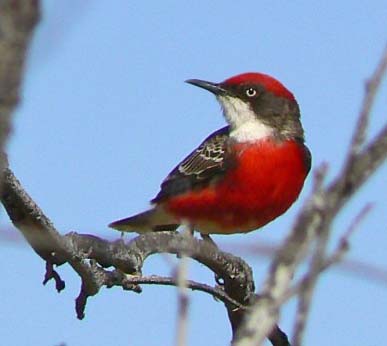 Another
interesting result of molecular studies was the discovery that
Australian chats, almost universally considered a separate family
"Epithianuridae," were aberrant honeyeaters. The five arid-adapted
species in two genera are terrestrial, mostly in the interior of
Australia. Crimson Chat (right, in a stunning shot by David Fisher) is an example; it is nomadic in drier woodlands and grasslands.
Another
interesting result of molecular studies was the discovery that
Australian chats, almost universally considered a separate family
"Epithianuridae," were aberrant honeyeaters. The five arid-adapted
species in two genera are terrestrial, mostly in the interior of
Australia. Crimson Chat (right, in a stunning shot by David Fisher) is an example; it is nomadic in drier woodlands and grasslands.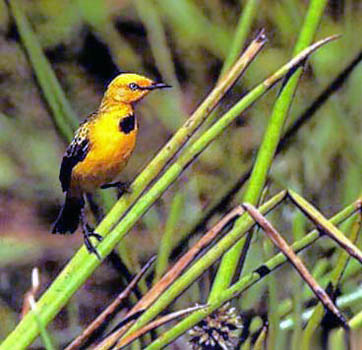

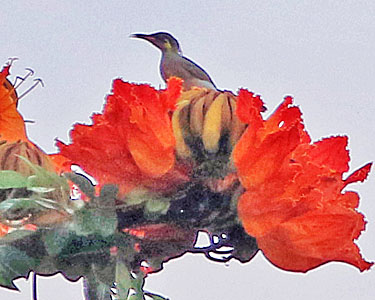 New Guinea boosts several successful rainforest groups. At one time the most confusing to birders were the Meliphaga
honeyeaters, have diversified into 15 species, some of them closely
resembling each other. Most were plain olive species with yellow spots
on the auriculars. Recent molecular studies have shattered those assumptions (Andersen et al. 2019, McCullough et al. 2019). Although there still are some 15 difficult honeyeaters, they are now divided into three genera (Meliphaga, Territornis, and Microptilotis) and just three are retained as Meliphaga honeyeaters. I'm not sure what name we can use for those "difficult olive honeyeaters with yellow facial spots," but there you have it. Did I mention that many are forest canopy birds and hard to see well? Here (right), sitting atop a huge flower in the lowland forests, is Elegant Honeyeater of New Guinea: once a Meliphaga but now in genus Microptilotis.
New Guinea boosts several successful rainforest groups. At one time the most confusing to birders were the Meliphaga
honeyeaters, have diversified into 15 species, some of them closely
resembling each other. Most were plain olive species with yellow spots
on the auriculars. Recent molecular studies have shattered those assumptions (Andersen et al. 2019, McCullough et al. 2019). Although there still are some 15 difficult honeyeaters, they are now divided into three genera (Meliphaga, Territornis, and Microptilotis) and just three are retained as Meliphaga honeyeaters. I'm not sure what name we can use for those "difficult olive honeyeaters with yellow facial spots," but there you have it. Did I mention that many are forest canopy birds and hard to see well? Here (right), sitting atop a huge flower in the lowland forests, is Elegant Honeyeater of New Guinea: once a Meliphaga but now in genus Microptilotis. 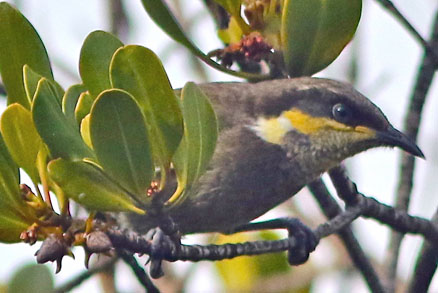 This brief summary of the
Meliphagidae can barely touch on the main groups. There are obscure and
fascinating species galore. Some are mangrove specialists; for example, the aptly-named Mangrove Honeyeater (left). Others are
wanderers in the arid Australian interior, as does Painted Honeyeater Grantiella picta, which specializes on mistletoe berries and is therefore nomadic. In many places, there may be
ten or more species, some of them feeding together at rich sources of
nectar or protein (e.g., outbreaks of lerps). In these circumstances,
larger species often dominate and exclude the smaller ones from the
richest niches, but all do reasonably well, utilizing adjacent minor
nectar sources. Having evolved in isolation and becoming successful,
honeyeaters offer rich areas for study (e.g., Blakers et al. 1994, Higgins et al. 2008).
This brief summary of the
Meliphagidae can barely touch on the main groups. There are obscure and
fascinating species galore. Some are mangrove specialists; for example, the aptly-named Mangrove Honeyeater (left). Others are
wanderers in the arid Australian interior, as does Painted Honeyeater Grantiella picta, which specializes on mistletoe berries and is therefore nomadic. In many places, there may be
ten or more species, some of them feeding together at rich sources of
nectar or protein (e.g., outbreaks of lerps). In these circumstances,
larger species often dominate and exclude the smaller ones from the
richest niches, but all do reasonably well, utilizing adjacent minor
nectar sources. Having evolved in isolation and becoming successful,
honeyeaters offer rich areas for study (e.g., Blakers et al. 1994, Higgins et al. 2008). 